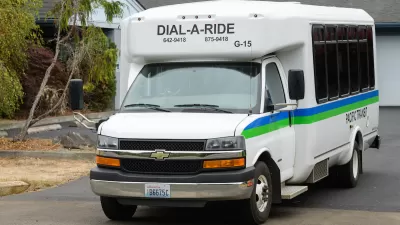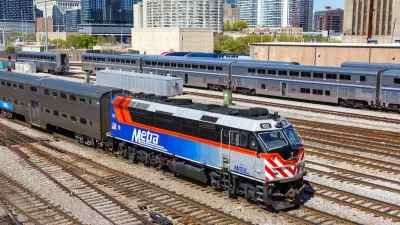On-demand microtransit is gaining popularity with transit agencies, but is it at the expense of existing service?

Transit advocates are sounding the alarm on the rapid rise of microtransit programs, which transit agencies around the country are turning to as an affordable way to supplement existing services but which some fear could undermine fixed-route services.
As Jared Brey reports in Governing, microtransit, particularly on-demand services, can help residents who aren’t otherwise well-served by transit services improve their mobility. However, “Advocates say it’s inefficient, highly expensive per rider and an opportunity cost for transit agencies that doesn’t increase ridership overall.”
Microtransit has its benefits, Brey notes, citing examples from Gwinnett County, Georgia, and Jersey City. It can vastly improve mobility options for rural residents, elderly people, and others who cannot or do not drive. But in some cases, the cost to the city is exceedingly high: programs in Los Angeles and Sacramento are costing those cities around $43 per ride.
To be fair, Brey notes, “All public transit is heavily subsidized, and many officials say it’s worth investing in options for people who don’t live near bus and train lines. But a key question is what microtransit is meant to accomplish.” For TransitCenter’s Chris Van Eyken, “Services should be judged on whether they increase overall ridership on a transit system,” and microtransit has not yet been shown to do so. The question remains whether microtransit offers “meaningful mobility at a community or city scale.”
FULL STORY: Microtransit Has Broad Appeal, Despite Clear Drawbacks

Alabama: Trump Terminates Settlements for Black Communities Harmed By Raw Sewage
Trump deemed the landmark civil rights agreement “illegal DEI and environmental justice policy.”

Planetizen Federal Action Tracker
A weekly monitor of how Trump’s orders and actions are impacting planners and planning in America.

The 120 Year Old Tiny Home Villages That Sheltered San Francisco’s Earthquake Refugees
More than a century ago, San Francisco mobilized to house thousands of residents displaced by the 1906 earthquake. Could their strategy offer a model for the present?

In Both Crashes and Crime, Public Transportation is Far Safer than Driving
Contrary to popular assumptions, public transportation has far lower crash and crime rates than automobile travel. For safer communities, improve and encourage transit travel.

Report: Zoning Reforms Should Complement Nashville’s Ambitious Transit Plan
Without reform, restrictive zoning codes will limit the impact of the city’s planned transit expansion and could exclude some of the residents who depend on transit the most.

Judge Orders Release of Frozen IRA, IIJA Funding
The decision is a victory for environmental groups who charged that freezing funds for critical infrastructure and disaster response programs caused “real and irreparable harm” to communities.
Urban Design for Planners 1: Software Tools
This six-course series explores essential urban design concepts using open source software and equips planners with the tools they need to participate fully in the urban design process.
Planning for Universal Design
Learn the tools for implementing Universal Design in planning regulations.
Clanton & Associates, Inc.
Jessamine County Fiscal Court
Institute for Housing and Urban Development Studies (IHS)
City of Grandview
Harvard GSD Executive Education
Toledo-Lucas County Plan Commissions
Salt Lake City
NYU Wagner Graduate School of Public Service





























